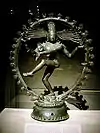Ayyappan
Ayyappan (Sastha or Dharmasastha or Manikandan) is a Hindu deity, particularly popular in the South Indian state of Kerala. Ayyapa is considered to be the union of Mohini (Vishnu) and Shiva. Although the worship of Ayyappa was more widespread earlier, his worship is now mainly confined to South India. Ayyappa is considered to be the ruler of the universe, and thus meditates alongside Vishnu and Shiva. He is considered to be the epitome of dharma, truth and righteousness and is often called upon to obliterate evil. The worship of Ayyappa has become very popular in the state of Kerala by members of all communities, in Tamil Nadu and Andhra Pradesh. The deity is mentioned in various scriptures and is a revered in south Indian Hindu traditions.
| Ayyappan | |
|---|---|
Strength, Courage, Self-control & Celibacy | |
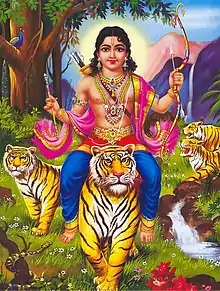 Swami Ayyappan | |
| Malayalam | അയ്യപ്പൻ |
| Affiliation | Hinduism |
| Abode | Sabarimala |
| Mantra | Swamiye Saranam Ayyappa |
| Weapon | Bow and arrow, Sword |
| Symbols | Bell, Bow and Arrow |
| Mount | Horse, Elephant, Tigress |
| Texts | Brahmanda Purana |
| Personal information | |
| Parents | |
| Part of a series on |
| Shaivism |
|---|
 |
| Part of a series on |
| Vaishnavism |
|---|
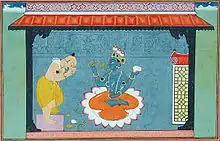 |
|
|
| Part of a series on |
| Hinduism |
|---|
 |
|
Although devotion to Ayyappan has been prevalent earlier, in South India, it has become popular only in the late 20th century.[1][2][3] According to Hindu theology, he is the son of Harihara (Mahavishnu in the form of Mohini and Shiva).[3][4] Ayyappan is also referred to as Ayyappa, Sastavu, Hariharasudhan, Manikandan, Shasta or Dharma Shasta and Sabarinath.[2][3]
The iconography of Ayyappan depicts him as a handsome celibate (Brahmachari) God doing yoga and as an epitome of Dharma, who wears a bell around his neck. In the Hindu pantheon, his legends are relatively recent but diverse. He is honored by Muslims in Kerala, with legends wherein Ayyappan defeats and gains worship of the Muslim brigand Vavar.[4][2][5] In the Hindu tradition popular in the Western Ghats of India, he was born with the powers of Shiva and Vishnu to confront and defeat the shape shifting evil Buffalo demoness Mahishi. He was raised by a childless royal couple Rajashekara pandiyan and Koperundevi, and grows up as a warrior yogi champion of ethical and dharmic living.[6][7][2] In the South Indian version, Ayyappan images show him as riding a tigress, but in some places such as Sri Lanka he is shown as riding a white elephant.[8][9]
Ayyappan popularity has grown in many parts of India, and the most prominent Ayyappan shrine is at Sabarimala, nestled in the hills of Pathanamthitta of Kerala. The shrine receives millions of pilgrims every year in late December and early January, many of whom prepare for weeks before and then climb the hill barefoot,[4] making it one of the largest active pilgrimage sites in the world.[10][11] The pilgrimage attracts a wide range of devotees, from diverse social or economic backgrounds, except women in their fertile age because Ayyappan is believed to be the celibate deity and a plethora of other scientific arguments to vindicate the same. It remains one of the few Deities in Hindu tradition, that are worshipped by all religious communities, including Muslims and Christians in Kerala.[2] The most significant festival linked to him is the Makaravilakku (Makara Sankranti), observed around the winter solstice.[3][12]
Names and iconography
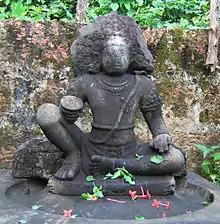
The name Ayyappan (sometimes spelled as Ayyappa or Aiyappan) may be related to as "Lord Father".The name may literally comes from "Ayyan" and "Appan" both meaning "Father". The root names "Ayyan" and "Appan" denotes Mohini (Mohini here called father because she is a form of Lord Perumal who is a male) and Lord Shiva respectively.[13] However, the word Ayyappan is not found in South Indian versions of the medieval era Puranas, leading scholars to the hypothesis that Ayyappan may have roots elsewhere. The alternate theory links it to the Malayali word acchan and Tamil word appa which means "father", with Ayyappan connoting "Lord-father".[14][15] The alternate proposal is supported by the alternate name for Ayyappan being Sastava (Sasta, Sashta, Sastra), a Vedic term that also means "Teacher, Guide, Lord, Ruler".[15] The words Sastha and Dharmasastha in the sense of a Hindu god are found in the Puranas.[16]
Ayyappan is also known as Hariharasudhan[17] – meaning the "son of Harihara" or a fusion deity of Hari and Hara, the names given to Vishnu and Shiva respectively.[18] He is also called Manikanta from Mani, Sanskrit for precious stone,[19] and kanta, Sanskrit for neck. In some regions, Ayyappa and Ayyanar are considered to be the same deity given their similar origin. Others consider him as different because their worship methods are not the same.[16]
Ayyappan is a warrior deity. He is revered for his ascetic devotion to Dharma – the ethical and right way of living, to deploy his military genius and daring yogic war abilities to destroy those who are powerful but unethical, abusive and arbitrary.[20] His iconography is usually shown with a bow and arrow upraised in his left hand, while in his right he holds either a bow or a sword diagonally across his left thigh.[21] Other depictions of Ayyappan, particularly paintings, generally show him in a yogic posture wearing a bell around his neck[2] and sometimes shown riding a tiger.[22]
Life and legends
The life legends and mythology of Ayyappa varies across region like other Hindu gods and goddesses, reflecting a tradition that evolved and enriched over time, sometimes in conflicting ways.[23][24] For example, the Sribhutanatha Purana text presents Ayyappan as an incarnation of the Hindu deity Hariharaputra, the son of Shiva and Mohini. This interaction between Shiva and Mohini is mentioned in the Bhagavata Purana, but Ayyappan is not mentioned.[25] In the oral tradition as represented by Malayalam folk songs, Ayyappa is presented as a warrior hero of Pandala kingdom. According to Eliza Kent, the legends in the Ayyappa tradition seem to be "artificially mixed and assembled into a kind of collage".[24] Ruth Vanita suggests that Ayyappan probably emerged from the fusion of a Dravidian god of tribal provenance and the Puranic story of Shiva and Mohini's interaction.[26]
Core story
There once was a kingdom of Pandalam where Ayyappan originated.[27] The royal family was childless. One day the king of Pandalam found a baby boy in a forest.[2][3][4] The king carried the baby to an ascetic in the forest to inquire about the boy.[27] The ascetic advised the king to take the baby home, raise him like his own son, and that in 12 years he would discover who the baby was.[27] The royal family did so, naming the baby Manikantha.[27]

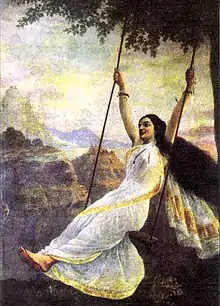
At age 12, the king wanted to formally invest Manikantha as the heir prince (yuvraja). However, the queen under the influence of an evil minister objected. The minister had advised the queen that only her younger biological child should be the next king. The younger child was disabled and lacked the ability to perform the duties of the king, something that the scheming evil minister thought would make him the de facto ruler.[27] The minister persuaded the queen to feign an illness, ask for "tiger's milk" to cure her illness and demand that Manikantha be sent to get the milk from the forest. Manikantha volunteers, goes into the forest and returns riding a tigress.[27] The king, realising Manikantha's special ability recognizes the adopted son to be a divine being, resolves to make a shrine for him. For location, Manikantha shoots an arrow that lands thirty kilometers away. The young boy then transforms into Ayyappan. The place where arrow landed is now an Ayyappa shrine, a site of a major pilgrimage that is particularly popular for visits on Makara Sankranti (about January 14).[29]
The above core story is shared wherever Ayyappan is revered in India.[30] Sometimes the story is slightly different or extended, such as the younger son of the queen is not disabled, Ayyappan does bring tigress milk for the queen riding on a tiger, but after doing so Ayyappan renounces the kingdom, becomes an ascetic yogi and returns to live as a great warrior in the forested mountain.[31]
Medieval interpretations

In the medieval age, the stories of Ayyappan expanded. One story has roots between the 1st and 3rd century CE, where Ayyappan evolves to be a deity who also protects traders and merchants from enemies such as robbers and plundering outlaws.[32] Ayyappa came to be portrayed as a military genius. His temple and tradition inspired Hindu yogi mercenaries who protected the trade routes in South India from criminals and looters, restoring Dharmic trading practices.[32]
In one of the stories, Ayyappan is portrayed as a child of a priest whose father was murdered by the fearsome outlaw Udayanan. The outlaw also kidnaps a princess. Ayyappan then makes a daring rescue, attacks and kills evil Udayanan.[32] In another version of this story, the rulers of Pantalam themselves sent Ayyappan as a mercenary to the Pantya rulers to whom the ruler of Pantalam was related. In another late medieval era variation of the story, Ayyappan forms an alliance with the Muslim warrior Vavar against Udayanan, the basis for some devotees worshiping both in a mosque and then in the Hindu temple before starting a pilgrimage to Ayyappan shrine.[32]
.jpg.webp)
According to Paul Younger, supplementary legends appeared by the late medieval times that linked other Hindu deities and mythologies to Ayyappan heritage.[32] One such story links Ayyappan to the buffalo-demon Mahishasura and buffalo-demoness Mahishasuri. The divine beings Datta and Lila came to earth as humans. Datta wanted to return to the divine realm, but Lila enjoyed her life on earth and Datta's company. She wanted to stay on earth.[33] Datta became angry and cursed her to become a Mahishi, or water buffalo demoness. Lila in turn cursed him to become a Mahisha, or water buffalo demon. They plundered earth with their evil acts. The water buffalo demon Mahishasura was killed by goddess Durga, while the water demoness Mahishasuri was killed by Ayyapan, ending the terror of evil and liberating divine Lila who was previously cursed.[34] These legends, states Younger, syncretically link and combine various Hindu traditions around Shiva (Shaivism), Vishnu (Vaishnavism) and Devi (Shaktism).[34]
Temples

There are many temples in Kerala whose presiding deity is Ayyappan, the most famous among them being the Sabarimala temple. Padinettam Padi Karuppan is Guardian Of Ayyappan temple. The temple attracts millions of visitors every year during mandala season from mid November to mid January. Other important temples are Kulathupuzha Sastha Temple, Aryankavu Sastha Temple, Achankovil Sree Dharmasastha Temple, Erumely Sree Dharmasastha Temple and Ponnambalamedu Temple.
Ayyappan temples typically show him as a celibate yogi. A few important temples such as the one at Achankovil Sree Dharmasastha Temple near Travancore, however, depict him as a married man with two wives Poorna and Pushkala, as well as a son Satyaka.[35][36] Some of Ayyappan temples are believed to have been established by the Vishnu avatar Parashurama.[37]
Sabarimala

Ayyappan has roots in Kerala, but his influence and popularity has grown among the Hindus in South Indian states. Of his many temples, the most significant is at Sabarimala (also spelled Sabarimalai), set in the forests of the pathanamthitta district Western Ghats on the banks of river Pamba, southeast of Kottayam. It is a major pilgrimage, attracting millions of Hindus every year, particularly of Malayali, Tamil, kannada and Telugu heritage.[38][39][40]
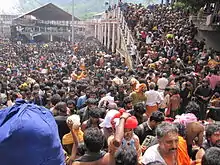
Many begin preparations months in advance by leading a simple life, doing yoga, abstaining from sex, eating a vegetarian diet or partially fasting, wearing black or blue or sadhu-style dress for forty one days, then trekking as a group to the shrine. The group does not recognize any form of social or economic discrimination such as caste, and all devotees form a fraternity welcoming each other as equals.[38][41][40] The pilgrims call each other by the same name during the trek: swami.[40][42] After their long walk covering about 18 miles, they bathe in the Pamba river, then they climb 18 steps at the Sabarimala shrine, each representing a dharmic value (ethics, or interiorized gods). The shrine priests and devotees bring flowers from all over the Western Ghats and scatter them near the shrine, all the while chanting shlokas.[38][43][44]
To keep the human traffic organized, Ayyappan devotees reserve and are assigned a pilgrimage day from one of the 51 days of pilgrimage, and each day sees over 100,000 walking pilgrims. Girls and older women are welcome and join the journey with men, but women between the ages of 10-50 are strictly prohibited in sabarimala. Because of the belief that Lord Ayyappan is a Brahmachari (celibate) deity.[38][2][43] The devotees wear simple dress on the day of the pilgrimage up the hills and through the forest, many go barefoot, carry irumudi (a walking stick for regional Hindu yogis with two compartment little bag sometimes carried on head), wear Tulasi leaves and Rudraksha beads around their neck (symbolism for Vishnu and Shiva) while fellow Hindus gather along the trek path, cheering and helping them complete their journey.[38][43] For the Ayyappan pilgrims, states E. Valentine Daniel, the pilgrimage is a part of their spiritual journey.[42]
Other Ayappan Temples in India
1. Ayappa Temple, RK Puram, New Delhi
2. Noida Ayappa Temple
3. Lord Ayappa Temple, Lucknow
4. Raja Annamalai Puram Ayappan Temple,R.A.Puram, Chennai
5. Sri Ayappa Swamy Temple, Hyderabad
6. Lord Shree Ayappa Temple - Gandhinagar Gujarat
7. Ayappa Temple - Jabalpur
8. Anna Nagar Ayyappan Koil, Chennai 9. Sree Ayyappa temple, Sector 7, Rohini, Delhi 10. Siddaputhur Ayyappan koil, Coimbatore 12.AYYAPPA SWAMI TEMPLE ,Arepally,Hanamakonda,warangal,Telangana.Famous temple not only ayyappa swami we can worship family of ayyappa swami. Swami saranam ayyappa. 11. Ayyappan koil, Ayyappan Kavu, Ernakulam (Near Ernakulam North Railway station), Kerala [45]
Other religions

He is also revered by Muslims in Kerala[4] due to his friendship with Vavar,[46] who is identified as a Muslim brigand in local versions of the Ayyappan myth.[47] In this mythology, Ayyappan confronts the plunder-driven pirate robber Vavar in the jungle on his way to collect tigress milk. They fight. Ayyappan defeats Vavar, and Vavar changes his way, becomes Ayyappan's trusted lieutenant helping fight other pirates and robbers.[48] In another version, Vavar is stated to be a Muslim saint from Arabia, who works with Ayyappan.[48]
A mosque dedicated to Ayyappan's lieutenant Vavar swami stands next to Kadutha swami shrine at the foot of the pilgrimage path, both as a form of guardian deities. Some pilgrims offer a prayer to both, before beginning their Sabarimala forest and mountain pilgrimage hike.[48] According to Kent, the mosque does not contain mortal remains of Vavar swami though the mosque near Sabarimala includes a grave, and no one can date Vavar nor provide when and where he lived, so he may be a myth. The Vavar legend and palli shrines may reflect the Hindu approach to accepting and co-opting legendary figures or saints of other religions within its fold.[49]
Movies and TV shows
The deity Ayyappan has appeared in several regional TV and movies as a character, such as the Swami Ayyappan in multiple languages.[50][51]
The story of Lord Ayyappa is also dictated by Mata Parvati to Lord Ganesha in a weekly show of SonyTV called Vighnaharta Ganesh from Episode 608 i.e. from 19 December 2019.[52]
Asianet (TV channel) launched a series named Sabarimala Swami Ayappan in 2019.
See also
- Achankovil
- Alappancode
- Aranmula kottaram (Aranmula palace)
- Gurunathanmukadi
- Harivarasanam
- Maalikapurathamma
- Makara Jyothi
- Pallikal kavu
- Sabarimala
- Tazhamon Madom
- Temples of Kerala
References
- Chandra, Suresh (1998). Encyclopaedia of Hindu Gods and Goddesses. Sarup and Sons. p. 28. ISBN 8176250392.
- "Ayyappan – Hindu deity". Encyclopaedia Britannica. 2014.
- Denise Cush; Catherine A. Robinson; Michael York (2008). Encyclopedia of Hinduism. Routledge. p. 78. ISBN 978-0-7007-1267-0.
- Constance Jones and Ryan James (2014), Encyclopedia of Hinduism, Infobase Publishing, ISBN 978-0-8160-5458-9, page 58
- "Hindu pilgrims pray at a mosque in Kerala – Latest News & Updates at Daily News & Analysis". 12 January 2010.
- Jeffery D. Long (2011). Historical Dictionary of Hinduism. Scarecrow Press. p. 78. ISBN 978-0-8108-7960-7.
- Younger 2002, pp. 17-21.
- MN Srinivas (2002). Collected Essays. Oxford University Press. p. 352. ISBN 978-0-19-565174-4.
- D. P. Dubey (1995). Pilgrimage Studies: Sacred Places, Sacred Traditions. SPS. pp. 136–137. ISBN 978-81-900520-1-6.
- Younger 2002, pp. 22–24.
- Press Trust of India (June 23, 2011). "Safety Manual for Sabarimala prepared". The New Indian Express. Archived from the original on 4 March 2016. Retrieved 13 July 2011.
- Roshen Dalal (2010). Hinduism: An Alphabetical Guide. Penguin Books. pp. 238, 350. ISBN 978-0-14-341421-6.
- Paul Williams; Anthony Tribe; Alexander Wynne (2012). Buddhist Thought: A Complete Introduction to the Indian Tradition. Routledge. p. 62. ISBN 978-1-136-52088-4.; Contemporary scholar Peter Harvey translates the term "arya satya" (see Four Noble Truths) as "True Realities for the Spiritually Ennobled" (Peter Harvey (2013), An Introduction to Buddhism, Cambridge University Press, page 52)
- Mikhail Sergeevich Andronov (1996). A Grammar of the Malayalam Language in Historical Treatment. Otto Harrassowitz Verlag. p. 49. ISBN 978-3-447-03811-9.
- Johannes Bronkhorst; Madhav Deshpande (1999). Aryan and non-Aryan in South Asia: evidence, interpretation, and ideology; proceedings of the International Seminar on Aryan and Non-Aryan in South Asia. Harvard University, Dept. of Sanskrit and Indian Studies. pp. 177–178. ISBN 978-1-888789-04-1.
- Roshen Dalal (2010). The Religions of India: A Concise Guide to Nine Major Faiths. Penguin Books. p. 43. ISBN 978-0-14-341517-6.
- Kumar, cited ref by author is (Sekar 2009, 479-84)
- Younger, p.22
- "maNi". Sanskrit Dictionary for Spoken Sanskrit. spokensanskrit.org. Retrieved 27 August 2017.
- Younger 2002, pp. 21–25.
- Williams, Joanna Gottfried (1981). Kalādarśana: American Studies in the Art of India. p. 72. ISBN 9004064982.
- "The mount of Swami Ayyappan is tiger". media4news.com.
- Younger 2002, pp. 18–25.
- Eliza Kent (2013). Lines in Water: Religious Boundaries in South Asia. Syracuse University Press. pp. 80–83. ISBN 978-0-8156-5225-0.
- Goudriaan, Teun (1978). "The Māyā of the Gods: Mohini". Māyā divine and human. Motilal Banarsidass Publ. pp. 42–43. ISBN 978-81-208-2389-1.
- Ruth Vanita; Saleem Kidwai (2000). Same-Sex Love in India: Readings in Indian Literature. Springer Publishing. p. 94. ISBN 1137054808.
- Younger 2002, p. 18.
- Eliza Kent (2013). Lines in Water: Religious Boundaries in South Asia. Syracuse University Press. pp. 79–80. ISBN 978-0-8156-5225-0.
- Younger 2002, pp. 18–19.
- Younger 2002, pp. 18–22.
- Devdutt Pattanaik (2014). Pashu: Animal Tales from Hindu Mythology. Penguin Books. pp. 109–111. ISBN 978-81-8475-692-0.
- Younger 2002, pp. 20–21.
- Younger 2002, p. 21.
- Younger 2002, pp. 21–22.
- K. Srikumaran (2005). Theerthayathra: A Pilgrimage Through Various Temples. Bharatiya Vidya Bhavan. pp. 103, 120. ISBN 978-81-7276-363-3.
- Pattanaik, Devdutt (9 January 2014). The Man Who Was a Woman and Other Queer Tales from Hindu Lore. Routledge. p. 127. ISBN 9781317766308.
- Maria A. David (2009). Beyond Boundaries: Hindu-Christian Relationship and Basic Christian Communities. ISPCK. p. 9. ISBN 978-81-8465-001-3.
- Fred Clothey (1978). Bardwell L. Smith (ed.). Religion and the Legitimation of Power in South Asia. BRILL Academic. pp. 3–9 with footnotes. ISBN 90-04-05674-2.
- Younger 2002, pp. 18-23.
- Diana L Eck (2012). India: A Sacred Geography. Random House. pp. 13–14. ISBN 978-0-385-53191-7.
- Eliza Kent (2013). Lines in Water: Religious Boundaries in South Asia. Syracuse University Press. pp. 14–15. ISBN 978-0-8156-5225-0.
- E. Valentine Daniel (1987). Fluid Signs: Being a Person the Tamil Way. University of California Press. pp. 244–262. ISBN 978-0-520-06167-5.
- Younger 2002, pp. 18–23.
- Stephen Knapp (2009). Spiritual India Handbook. Jaico. pp. 416–419. ISBN 978-81-8495-024-3.
- https://en.wikipedia.org/wiki/Anna_Nagar_Ayyappan_Koil,_Chennai
- Mohammada, Malika (23 August 2017). "The Foundations of the Composite Culture in India". Aakar Books. Retrieved on 23 August 2017 – via Google Books.
- Osella, Caroline; Osella, Filippo (23 August 2017). "Men and Masculinities in South India". Anthem Press – via Google Books.
- Eliza Kent (2013). Lines in Water: Religious Boundaries in South Asia. Syracuse University Press. pp. 81–86. ISBN 978-0-8156-5225-0.
- Eliza Kent (2013). Lines in Water: Religious Boundaries in South Asia. Syracuse University Press. pp. 84–88. ISBN 978-0-8156-5225-0.
- Jayan, Arun (December 17, 2012). "Toon 'Swami Ayyappan' all set to hit theatres". New Indian Express. Retrieved June 6, 2014.
- "Ayyappan now in toon avatar". The Hindu. June 20, 2012. Retrieved 2014-06-21.
- "Ep. 608 - Story Time For The Kids - Vighnaharta Ganesh". SonyLIV.
Bibliography
- Younger, Paul (2002), Playing Host to Deity: Festival Religion in the South Indian Tradition, Oxford University Press, ISBN 0195140443
- Kumar, P. Pratap (2014). Contemporary Hinduism. Routledge. ISBN 978-1317546351.
External links
![]() Media related to Ayyappan at Wikimedia Commons
Media related to Ayyappan at Wikimedia Commons
- Sree Ayyappa Temple, RK Puram Delhi
- Historical and Mythological details about Swamy Ayyapa
- About Lord Swamy Ayyappa
- Malaysian Lord Ayyappa Charity and Welfare Organisation
- Oldest site on Lord Ayyappan (Non profit Org)
- Lord Ayyappan History (Non profit Org)
- Ayappa Temple, Nigdi, Pune
- London Ayappan Temple, UK
- Sastha Ayyanar and Ayyappan
- Ashta Sastha Temple
- Songs on Ayyappan fight with King Udayan and the Mukkal Vettom temple


